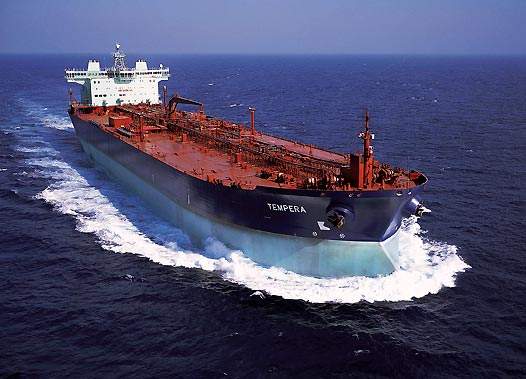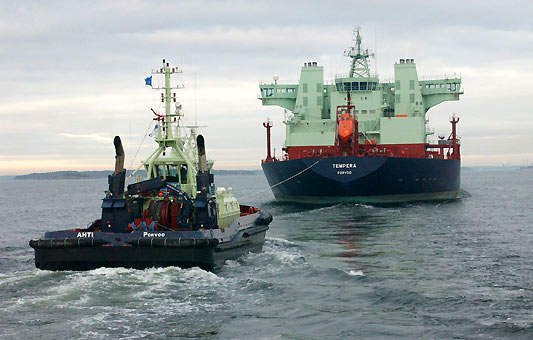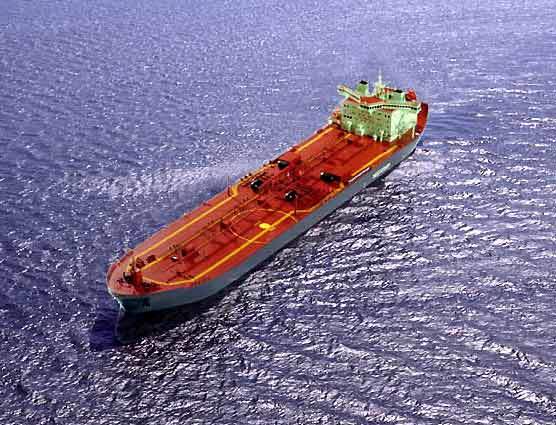The Tempera was built at the Sumitomo Heavy Industries yard in Japan for the Finnish group Fortum Oil and Gas. It is the first cargo tanker ship in the world to adopt the Double Acting Tanker (DAT) design developed by Kvaerner Masa-Yards. Its sister ship will be the M/T Mastera. These vessels are planned to work in the Baltic Sea area.
DOUBLE ACTING TANKER (DAT)
The principle behind the DAT concept is that, like most vessels, it travels ahead on normal open water and thus has a highly hydrodynamic shaped bow and sides. When it sails in ice however, it travels astern where the reinforced stern hullform is used to break the ice. The podded propulsion system is used to produce a water stream between the ice and the hull, lubricating the contact.
The hull structure features a specially reinforced double skin with a fatigue life of 40 years. The bunker tanks are protected by a double skin coffer dam and there is a double bottom which protects the pump room.
SHIP PROPULSION
The propulsion is provided by an Azipod unit. This contains the electric motor and the fixed pitch propeller. This is pod can rotate at 360° and has a maximum rating of 16MW although the nominal output is 15MW. This gives the tanker a speed of 17 knots in open water. In ice, the tanker can go at 3 knots in ice 1m thick. For manoeuvring into port, there is also a bow thruster. ABB supplied the complete electric propulsion system.
TANKS AND PUMPS
The tanker has 12 cargo tanks which are divided by a central bulkhead, as well as two slop tanks, which gives it a capacity of 121,158m³ at 98%. There is an inert gas system for the slop and cargo tanks. The cargo and slop tanks have steam heating coils. The steam is produced by two oil-fired boilers with internal water tubes.
The tanks are filled and drained using four pumps located in the pump room next to the engine room at the aft end. There are three electrically driven cargo oil pumps which operate at a rate of 3,500m³/h each. There is also a cargo stripping pump which works at 300m³/h. Amidships is the cargo manifold system, which contains three manifolds. Hose handling is performed by a 15t crane with a maximum reach of 8m. Offloading takes 12 hours and requires 17t of fuel. Loading takes ten hours and uses 3.5t.
The epoxy coated ballast water tanks are located in the side and double bottom tanks. There are 12 tanks surrounding the cargo, and these are separated by a longitudinal bulkhead. There are also two fore and two aft peak tanks. These 16 tanks have a total capacity of 46 944m³. It is possible to carry out an emergency cargo transfer into the double hull.
The ballast water is transferred by two electric powered pumps. One pumps at 1,500m³/h and the other at 3,000m³/h.
There are also three tanks that hold drinking water, fresh water and ‘technical’ water. These have a combined holding capacity of 324m³.
ENGINES
Power is supplied by five Wartsila diesel gensets. These comprise two 6MW 0L38B diesel engines, two 4MW 6L38B diesel engines (all of which use heavy fuel oil at a rate of 56t/day when at 13.5 knots). These produce 6.6kA of AC current at 60Hz each. This is then fed into a switchboard and onto the cycloconverter which is linked to the pod motor.
For use in harbour there is one 1.7MW 6L26A diesel engine. It burns MDO, which is stored in a 308m³ tank. There is a 63.2m³ tank for lub oil.









